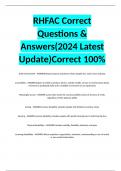RHFAC Correct
Questions &
Answers(2024 Latest
Update)Correct 100%
built environment - ANSWER physical spaces and places where people live, work, learn and play
accessibility - ANSWER degree to which a product, device, activity, facility, service or environment allows
everyone to participate fully and is available to everyone on an equal basis
Meaningful access - ANSWER access that meets the real accessibility needs of all users of a Site,
regardless of their physical ability
Seeing - ANSWER sensory disability, includes people with blindness and low vision
Hearing - ANSWER sensory disability, includes people with partial hearing loss to total hearing loss
Physical disabilities - ANSWER includes mobility, flexibility, dexterity, and pain
Learning disabilities - ANSWER affects acquision, organization, retention, understanding or use of verbal
or non-verbal information
,Developmental disabilities - ANSWER occur from birth or early childhood, inhibit or delay an individual's
ability to perform a number of tasks
Mental health related - ANSWER disorders that affect mood, thinking and behaviour
Memory - ANSWER affects storage, retention, and recollection of memories
Communication disabilities - ANSWER impact speaking or understanding spoken language, can overlap
with other challenges such as learning difficulties, cognitive challenges, or an aspect of autism spectrum
disorders, mental health-related problems, or hearing-related conditions
Visible vs. invisible disabilities - ANSWER physical are often visible, learning disability or mental health
are hidden
An employment equity program that does not provide a hiring process that is open to people with
disabilities:
No hiring forms/applications in Braille, large print or other alternative formats,
No telephone device for the deaf (TDD) so that people with hearing loss can talk directly to HR staff,
Physically inaccessible offices,
Rigid office hours or dress codes
Information or communications barriers - ANSWER happen when a person can't easily understand
information,
Print that is too small or in a font that is difficult to read,
Videos that are not captioned and/or don't have transcriptions,
Signs that are not clear or easily understood,
Websites that can't be accessed by people who are not able to use a mouse or view a conventional
screen,
Handouts or printed material that are available only in hard copies
Technology barriers - ANSWER occur when a device or technological platform is not accessible to its
intended audience and cannot be used with an assistive device,
, Electronic documents that lack proper formatting and cannot be read by screen-reading software,
Websites that cannot be adjusted for font size and contrast or accessed using screen-reading software
Person first language examples - ANSWER person who is blind, person who is deaf, person with a
disability, person who uses a wheelchair
Disability etiquette - ANSWER Ask how you can help
Communication etiquette - ANSWER speak to the person not their assistant, place yourself at eye level
for wheelchair users,
RHFAC adjudication - ANSWER rating review process, ensures rating score and certification level are
accurate
CSA Group - ANSWER develops accessibility standards (and others)
Rating Score - ANSWER final percentage score on the rating scorecard calculated by the total earned
points divided by the available points, determines certification level awarded
RHF accessibility certified - ANSWER a site that has met the certification prerequisite and achieved a final
rating score of at least 60%
RHF accessibility certified gold - ANSWER a site that has met the gold certification prerequisites and has
achieved a final rating score of at least 80%
RHFAC rating - ANSWER measure the level of meaningful access of a site and consists of, 1, on-site visit
or review of pre-construction drawings and 2. Submission of the rating on the RHFAC registry
Rating survey - ANSWER questionnaire used to complete the rating
Medical model of disability - ANSWER disability as a medical condition and expects the person with the
disability to change to fit with society




